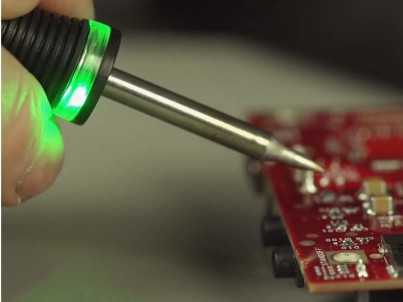The end of the cold solder joint
November 16, 2017
on
on
The intermetallic compound (IMC) thickness is a key parameter for determining the quality of a solder joint. When it is too thin, less than about 0.25 µm, the joint is “cold”; when it is too thick, 4 µm and more, it is brittle. The optimum IMC thickness is around 1 µm.

Placing the soldering iron’s tip on the joint to solder creates a power demand, indicating the beginning of a solder event. The system monitors the power demand until a change is detected, indicating the completion of the thermal bridge. At this point the solder has become completely fluid.
The system now calculates the intermetallic compound (IMC) thickness as a function of temperature and time. The cartridge (“soldering iron”) lights up green when the correct IMC thickness of about 1 µm has formed. Any error occurring during the process is signalled by a red light.
Update from Elektor Editor Jan Buiting: @ productronica 2017 in Munich. I personally tested the system. The result: perfect solder joints for SMD as well as TH parts. This thing is packed with parameters and intelligence.
Solder joint quality
Currently the quality of solder joints is mainly determined by visual inspection but Metcal has developed a method to make the soldering iron do it instead. Connection Validation (CV), as the technique is called, provides immediate visual feedback about the quality of the solder joint during soldering.
Placing the soldering iron’s tip on the joint to solder creates a power demand, indicating the beginning of a solder event. The system monitors the power demand until a change is detected, indicating the completion of the thermal bridge. At this point the solder has become completely fluid.
The system now calculates the intermetallic compound (IMC) thickness as a function of temperature and time. The cartridge (“soldering iron”) lights up green when the correct IMC thickness of about 1 µm has formed. Any error occurring during the process is signalled by a red light.
Update from Elektor Editor Jan Buiting: @ productronica 2017 in Munich. I personally tested the system. The result: perfect solder joints for SMD as well as TH parts. This thing is packed with parameters and intelligence.
Read full article
Hide full article



Discussion (3 comments)
Jim Smith 7 years ago
First, "cold" solder is a horrible term. The condition is lack of wetting, not lack of heat. (Most operators "fix" the "cold" solder but cranking up the soldering iron temperature. At a typical soldering iron temperature, solder will adhere to an oxidized or contaminated metal surface to give the false impression of reliability.)
Second, the only people who need this grotesquely expensive Metcal "intelligence" are those who do not know how to assess flow of solder while it is applied. This is a tragic consequence of our industry's belief that memorizing images of solder connections reflects the ability to actually make those desired connections. Certifying to documents such as J-STD-001 and A-610 makes no sense except to impress prospective clients who do not understand true solder reliability.
The same ignorance underlies the belief that a constant iron temperature prevents heat damage. An improperly wielded constant temperature iron is no less lethal than an improperly wielded iron of inconsistent temperature.
James A. Smith, PhD ABD
President
Electronics Manufacturing Sciences, Inc.
St. Petersburg, FL33711-4431 USA
https://www.emsciences.com
Blackdog 7 years ago
Raymond Frost 7 years ago